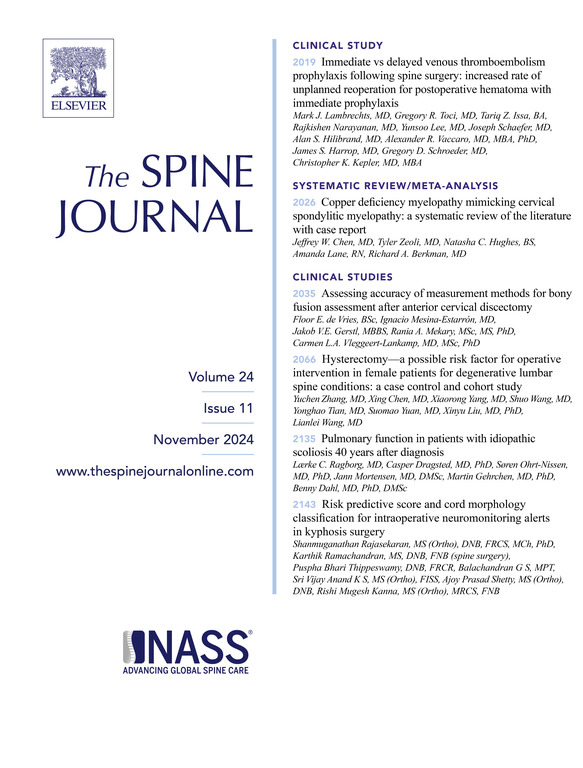In vitro comparison of endplate preparation in biportal endoscopic and microscopic tubular transforaminal lumbar interbody fusion procedures
IF 4.7
1区 医学
Q1 CLINICAL NEUROLOGY
引用次数: 0
Abstract
BACKGROUND
Successful spinal fusion heavily depends on the condition of endplate preparation in transforaminal lumbar interbody fusion (TLIF). The microscopic tubular (MT) approach offers a fixed surgical field outside the body and primarily relies on tactile feedback for endplate preparation. In contrast, the biportal endoscopic (BE) approach offers a flexible surgical field of view inside the body, allowing for direct visualization of the entire process of endplate preparation. These differences may affect the adequacy and completeness of endplate preparation.
PURPOSE
To evaluate the adequacy and completeness of endplate preparation in BE- and MT-TLIF.
STUDY DESIGN/SETTING
Anatomical study of human cadavers.
OUTCOME MEASURES
A quantitative assessment was performed using digital imaging software to calculate the percentage of the prepared endplate area (Prep %), which evaluated the adequacy of endplate preparation by comparing the prepared endplate cross-sectional area to the total endplate area. The entire endplate was divided into a grid of 6 × 8 pixels to evaluate the completeness of endplate preparation. Each pixel was qualitatively scored on a 4-point scale (0–3 points) based on the extent of bony endplate exposure and was counted based on its score. The percentage relative to the total number of pixels (Pixel%) was calculated.
METHODS
Four cadaveric torsos were procured for the study. Three lumbar segments were prepared using BE- and MT-TLIF techniques in each cadaver, totaling twelve intervertebral discs and twenty-four endplates. After completing endplate preparations using each approach, the lumbar spines were excised from the cadaveric torsos. Each disc space of the lumbar spine was dissected and split open in the axial plane at the center to expose the cranial and caudal endplates. These endplates were digitally photographed, followed by a quantitative and qualitative assessment of endplate preparation. The difference between the 2 approaches was then evaluated.
RESULTS
In terms of adequacy of endplate preparation, the Prep% was significantly larger with the BE than with the MT approach (55.10%; 44.94%; p=.001). Notably, when the entire endplate was divided into quadrants for analysis, the BE approach had significantly larger Prep% in the contralateral anterior and contralateral posterior quadrants (p<.001). In evaluating the completeness of endplate preparation, the Pixel% with complete endplate exposure (3 points) was significantly higher with the BE approach than with the MT approach (15.60%; 5.93%; p<.001). There was no significant difference in the Pixel% scored as 0, 1, or 2 points (p>.05).
CONCLUSION
The results of this study indicate that the BE approach provides significantly better adequacy and completeness of endplate preparation than the MT approach in TLIF surgery.
CLINICAL SIGNIFICANCE
The improved adequacy and completeness of endplate preparation using the BE approach could translate into better fusion outcomes in TLIF surgery. The BE technique may allow for a more thorough preparation of the endplate, reducing the risk of fusion failure and cage subsidence.
双门静脉内窥镜和显微管状椎间孔腰椎椎体间融合术中终板制备的体外比较。
背景:椎间孔腰椎椎体间融合术(TLIF)的成功在很大程度上取决于终板准备的条件。显微管(MT)入路在体外提供固定的手术视野,主要依靠触觉反馈进行终板准备。相比之下,双门静脉内窥镜(BE)入路在体内提供了一个灵活的手术视野,可以直接看到终板制备的整个过程。这些差异可能影响终板制备的充分性和完整性。目的:评价BE-和MT-TLIF终板制备的充分性和完整性。研究设计/设置:人体尸体解剖研究。结果测量:使用数字成像软件进行定量评估,计算制备终板面积的百分比(Prep %),通过比较制备终板横截面积与总终板面积来评估终板制备的充分性。将整个终板划分为6×8像素网格,评价终板制备的完备性。每个像素根据骨终板暴露程度以4分制(0-3分)进行定性评分,并根据其评分进行计数。计算相对于总像素数的百分比(Pixel%)。方法:选取4具尸体进行研究。每具尸体采用BE-和MT-TLIF技术制备3个腰椎节段,共12个椎间盘和24个终板。采用每种入路完成终板准备后,从尸体躯干切除腰椎。切开腰椎各椎间盘间隙,在中心轴向面切开,露出颅和尾端终板。对这些终板进行数码拍照,然后对终板制备进行定量和定性评估。然后评估两种方法之间的差异。结果:在终板制备的充分性方面,BE方法的Prep%明显大于MT方法(55.10%;44.94%;p = 0.001)。值得注意的是,当整个终板被分成象限进行分析时,BE入路在对侧前象限和对侧后象限的Prep%明显更大(p0.05)。结论:本研究结果表明,在TLIF手术中,BE入路提供的终板准备的充分性和完整性明显优于MT入路。临床意义:采用BE入路提高终板准备的充分性和完整性可以转化为TLIF手术中更好的融合结果。BE技术可以更彻底地准备终板,降低融合失败和保持架下沉的风险。
本文章由计算机程序翻译,如有差异,请以英文原文为准。
求助全文
约1分钟内获得全文
求助全文
来源期刊

Spine Journal
医学-临床神经学
CiteScore
8.20
自引率
6.70%
发文量
680
审稿时长
13.1 weeks
期刊介绍:
The Spine Journal, the official journal of the North American Spine Society, is an international and multidisciplinary journal that publishes original, peer-reviewed articles on research and treatment related to the spine and spine care, including basic science and clinical investigations. It is a condition of publication that manuscripts submitted to The Spine Journal have not been published, and will not be simultaneously submitted or published elsewhere. The Spine Journal also publishes major reviews of specific topics by acknowledged authorities, technical notes, teaching editorials, and other special features, Letters to the Editor-in-Chief are encouraged.
 求助内容:
求助内容: 应助结果提醒方式:
应助结果提醒方式:


